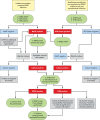Practical Guidance for Clinical Microbiology Laboratories: Mycobacteria
- PMID: 29386234
- PMCID: PMC5967691
- DOI: 10.1128/CMR.00038-17
Practical Guidance for Clinical Microbiology Laboratories: Mycobacteria
Abstract
Mycobacteria are the causative organisms for diseases such as tuberculosis (TB), leprosy, Buruli ulcer, and pulmonary nontuberculous mycobacterial disease, to name the most important ones. In 2015, globally, almost 10 million people developed TB, and almost half a million patients suffered from its multidrug-resistant form. In 2016, a total of 9,287 new TB cases were reported in the United States. In 2015, there were 174,608 new case of leprosy worldwide. India, Brazil, and Indonesia reported the most leprosy cases. In 2015, the World Health Organization reported 2,037 new cases of Buruli ulcer, with most cases being reported in Africa. Pulmonary nontuberculous mycobacterial disease is an emerging public health challenge. The U.S. National Institutes of Health reported an increase from 20 to 47 cases/100,000 persons (or 8.2% per year) of pulmonary nontuberculous mycobacterial disease among adults aged 65 years or older throughout the United States, with 181,037 national annual cases estimated in 2014. This review describes contemporary methods for the laboratory diagnosis of mycobacterial diseases. Furthermore, the review considers the ever-changing health care delivery system and stresses the laboratory's need to adjust and embrace molecular technologies to provide shorter turnaround times and a higher quality of care for the patients who we serve.
Keywords: BCG; Mycobacterium bovis; Mycobacterium tuberculosis; NTM; diagnostic algorithm; mycobacterial diseases; mycobacterium; nontuberculous mycobacteria; review; tuberculosis.
Copyright © 2018 American Society for Microbiology.
Figures
References
-
- Pfyffer GE. 2015. Mycobacterium: general characteristics, laboratory detection, and staining procedures, p 536–569. In Jorgensen JH, Pfaller MA, Carroll KC, Funke G, Landry ML, Richter SS, Warnock DW (ed), Manual of clinical microbiology, 11th ed, vol 1 ASM Press, Washington, DC.
Publication types
MeSH terms
LinkOut - more resources
Full Text Sources
Other Literature Sources
Medical


